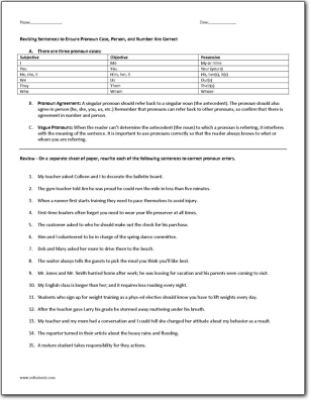Pronoun Cases
Revising Sentences to Ensure Pronoun Case, Person, and Number Are Correct
A. There are three pronoun cases: subjective, objective, and possessive.
Subjective case pronouns are used as the subject of a sentence.
Example: She is my older sister, and he is my younger brother.
Objective case pronouns serve as the objects of verbs or prepositions.
Example: My father made lunch for my Todd and me;
Possessive case pronouns show possession.
Example: My mother drove her car to the gas station.
B. Pronoun Agreement: A singular pronoun should refer back to a singular noun (the antecedent). The pronoun should also agree in person (he, she, you, us, etc.) Remember that pronouns can refer back to other pronouns, so confirm that there is agreement in number and person.
C. Vague Pronouns: When the reader can't determine the antecedent (the noun) to which a pronoun is referring, it interferes with the meaning of the sentence. It is important to use pronouns correctly so that the reader always knows to what or whom you are referring.
Pronoun CasesA. There are three pronoun cases: subjective, objective, and possessive.
Subjective case pronouns are used as the subject of a sentence.
Example: She is my older sister, and he is my younger brother.
Objective case pronouns serve as the objects of verbs or prepositions.
Example: My father made lunch for my Todd and me;
Possessive case pronouns show possession.
Example: My mother drove her car to the gas station.
B. Pronoun Agreement: A singular pronoun should refer back to a singular noun (the antecedent). The pronoun should also agree in person (he, she, you, us, etc.) Remember that pronouns can refer back to other pronouns, so confirm that there is agreement in number and person.
C. Vague Pronouns: When the reader can't determine the antecedent (the noun) to which a pronoun is referring, it interferes with the meaning of the sentence. It is important to use pronouns correctly so that the reader always knows to what or whom you are referring.

Related Links:
Pronoun cases: subjective, objective, and possessive


